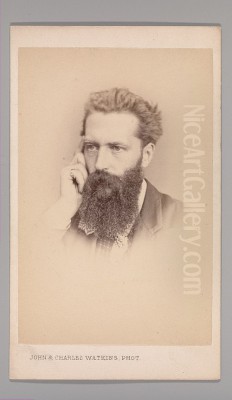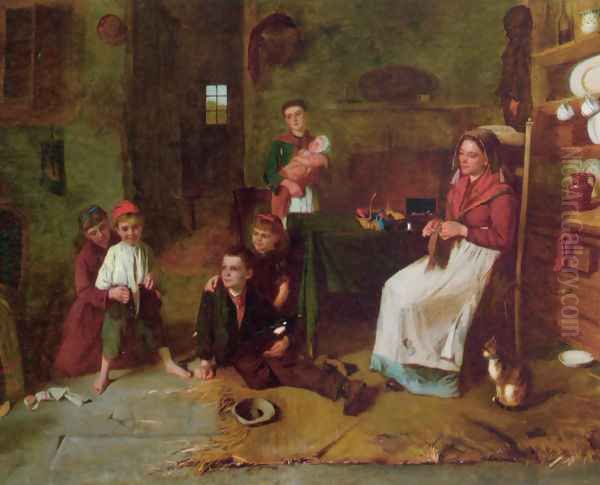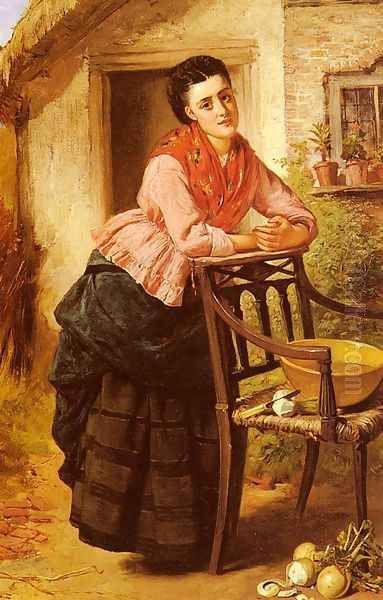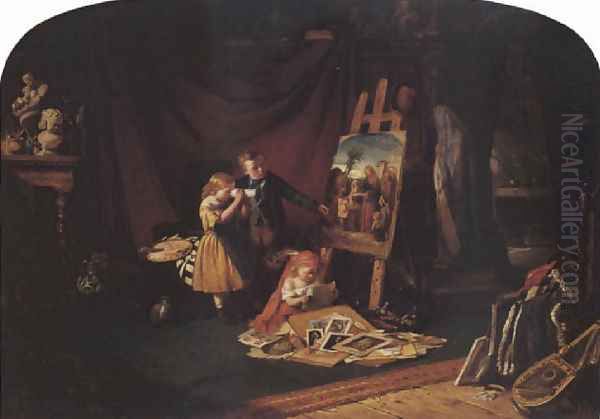
The tapestry of art history is woven with threads of varying prominence. While some artists achieve enduring global fame, others remain figures whose contributions are known within specific circles or whose life stories are pieced together from fragmented records. Edward Charles Barnes, a British artist active during the Victorian era, appears to fall into the latter category. Spanning the years 1830 to 1882, his life coincided with a period of significant change and development in British art and society.
Understanding Barnes requires navigating a historical record that presents certain ambiguities. However, available information points towards an artist engaged with the popular genres of his time, contributing to the rich visual culture of 19th-century Britain through portraiture and scenes of everyday life. His work, as suggested by descriptions, likely reflected the tastes and sensibilities prevalent during Queen Victoria's reign.
Origins and Early Life
Edward Charles Barnes is recorded as having been born in 1830. His place of birth is noted as Hucknall Huthwaite, a town in Nottinghamshire, England. This area, known for its industrial heritage, particularly coal mining, provides a specific geographical anchor for his origins. However, details regarding his family background and upbringing, especially concerning any early artistic inclinations or training, remain scarce in readily accessible records.
Unlike some contemporaries whose paths to artistic careers are well-documented through letters, diaries, or academic records, Barnes's formative years are less clear. We lack specific information about his formal education or whether he apprenticed under established artists. This absence of detail makes it challenging to trace the influences that shaped his initial development as a painter.
The Victorian era saw varied paths into the arts. Some artists emerged from established artistic families, others attended prestigious institutions like the Royal Academy Schools in London, while some were largely self-taught or received regional training. Without further evidence, placing Barnes definitively within one of these trajectories is difficult. His origins in Hucknall Huthwaite might suggest a background outside the main artistic centres, but this remains speculative.
Artistic Focus: Portraiture and Genre Painting

The available information identifies Edward Charles Barnes primarily as a practitioner of portraiture and genre painting. These were highly popular and commercially viable fields in Victorian Britain. Portraiture served the essential function of recording likenesses for families, individuals, and institutions, while genre painting captured scenes of everyday life, often imbued with narrative, sentiment, or moral commentary.
Barnes's style is described as elegant and serene. This suggests an approach characterised by refinement and a calm sensibility, rather than dramatic intensity or overt emotionalism. Emphasis was reportedly placed on the detailed depiction of posture and clothing, key elements in conveying the status, personality, and fashion of the sitter in portraiture, or in establishing the setting and character types in genre scenes. Such attention to detail was a hallmark of much Victorian painting.
The elegance attributed to his style might align him with the smoother finishes and refined compositions favoured by many academic painters of the period, standing in contrast to the more radical stylistic experiments emerging elsewhere. Artists like Sir Francis Grant or later figures such as James Sant were highly successful portraitists known for their flattering and sophisticated depictions of Britain's elite. While direct comparisons are difficult without viewing a wide range of Barnes's work, the description suggests an artist working within established conventions of taste.
Genre painting in the Victorian era encompassed a vast range of subjects, from domestic interiors and rural life to historical anecdotes and scenes with social commentary. Artists like William Powell Frith captured sprawling contemporary scenes, while others like Thomas Webster focused on charming vignettes of childhood and family life. Barnes's contribution to this field likely involved similar explorations of narrative and character within carefully composed settings.
Representative Works
While a comprehensive catalogue of Edward Charles Barnes's output is not readily available, specific titles attributed to him offer clues about his subject matter. Works mentioned include The New Breeches, A Rest from Labour, and The Haircut. These titles strongly suggest genre scenes, focusing on relatable moments of domestic life or work.

The New Breeches likely depicts a scene involving childhood, perhaps a young boy proudly wearing new clothes, a common sentimental theme in Victorian art. A Rest from Labour points towards a scene depicting workers, possibly rural labourers or artisans, taking a break – a subject allowing for character study and perhaps a gentle reflection on the rhythms of work and life. The Haircut similarly suggests an intimate, everyday scene, potentially set within a home or a barber's shop.
These titles align perfectly with the characteristics of Victorian genre painting, which often found charm, humour, or pathos in the ordinary. Without access to the images themselves, detailed analysis is impossible, but the titles alone place Barnes firmly within this popular tradition. They suggest an interest in narrative moments and the depiction of recognisable human activities and interactions.
The scarcity of widely reproduced images or detailed descriptions of these specific works highlights the challenge in fully assessing Barnes's artistic contribution. Many competent artists of the period catered to a market that valued such scenes, but their works may not have consistently entered major public collections or received extensive critical attention, leading to relative obscurity for later generations.
The Victorian Art Context
To appreciate Edward Charles Barnes's likely artistic environment, one must consider the broader landscape of Victorian art. His lifespan (1830-1882) placed him amidst a dynamic and diverse scene. The Royal Academy of Arts remained a dominant institution, shaping tastes through its annual exhibitions, though its influence was also challenged by emerging movements and alternative venues.
Portraiture, Barnes's reported specialty, was thriving, with artists like George Frederic Watts bringing psychological depth to the genre, while James McNeill Whistler would later introduce radical aesthetic ideas. Genre painting saw immense popularity, with artists like Luke Fildes tackling social realism, while others like Marcus Stone specialised in romantic historical vignettes.
The Pre-Raphaelite Brotherhood, founded in 1848 by figures such as Dante Gabriel Rossetti, John Everett Millais, and William Holman Hunt, had a profound impact, advocating for intense detail, vibrant colour, and subjects drawn from literature and religion, executed with a perceived 'truth to nature'. Although founded before Barnes was fully established, their influence persisted. Later artists associated with the movement's legacy, like Edward Burne-Jones, explored Symbolist themes and decorative medievalism, pushing British art in new directions.

Landscape painting also flourished, moving from the Romanticism of J.M.W. Turner (who died in 1851) towards greater naturalism. The so-called "Barnes School" of painters, associated with artists like Charles Edward Williams (though distinct from Edward Charles Barnes), focused on landscape, indicating regional artistic activity. The period also saw the rise of photography, which began to challenge the role of painting as a purely documentary medium.
Furthermore, the era witnessed the growth of art collecting and patronage beyond the traditional aristocracy. Industrial wealth created new collectors, some with distinct tastes. Figures like Albert C. Barnes (a later American collector, not to be confused with the subject) would amass significant collections, often with the help of artists like William Glackens, favouring Impressionist and Post-Impressionist masters such as Pierre-Auguste Renoir, Paul Cézanne, Vincent van Gogh, and Pablo Picasso – representing artistic trends that were developing towards the end of Edward Charles Barnes's life and would dominate the following century.
Edward Charles Barnes worked within this complex milieu. His focus on portraiture and genre, combined with a described style of elegance and detailed rendering, suggests an artist aligned with the more traditional, yet highly popular, streams of Victorian art, catering to the tastes of a public that valued recognisable subjects, skilled execution, and refined sentiment. He was a contemporary of major figures like Frederic Leighton and Lawrence Alma-Tadema, known for their classical and historical scenes executed with polished technique.
Later Life and Legacy
Edward Charles Barnes's life concluded in 1882. The records indicate his place of death as Belgium. The circumstances surrounding his presence and death there are not detailed in the context of his artistic career. This adds another layer of geographical complexity to his life story, which began in the English Midlands.
Information regarding potential collaborations with other artists or direct involvement in specific art movements or societies is notably absent from the available sources. Similarly, there are no widely recorded anecdotes or personal accounts that might offer a more intimate glimpse into his personality or working methods. This lack of supplementary detail contributes to his relatively low profile in mainstream art historical narratives.

His legacy primarily resides in the works he created, even if many are not widely known today. As a portrait and genre painter working in the Victorian era, he participated in a rich artistic tradition. His paintings likely captured aspects of British life and society during a period of profound transformation. The elegance and serenity noted in descriptions of his style suggest a contribution that valued aesthetic refinement and careful observation.
The historical record, as pieced together, presents Edward Charles Barnes as a competent British artist of the 19th century, specialising in portrait and genre subjects. While not reaching the towering fame of some contemporaries, his work, represented by titles like The New Breeches and A Rest from Labour, formed part of the broad artistic output that defined the Victorian age. His life, spanning from Hucknall Huthwaite to a final chapter in Belgium, reflects the movements and possibilities of his time, even as many details of his journey remain elusive. He remains a figure whose full artistic story perhaps awaits further discovery in less-explored archives or private collections.